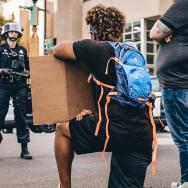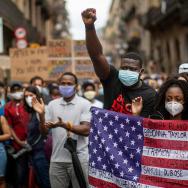In the United States, being released from jail or prison does not mean a person has complete freedom. Millions of people living with felony records must still navigate laws and policies that limit their rights as citizens, their ability to participate in society and even their relationships with family and friends.
So argues Asst. Prof. Reuben Jonathan Miller of the Crown Family School of Social Work, Policy and Practice, who traces the lived realities of formerly incarcerated people in his new book, Halfway Home: Race, Punishment and the Afterlife of Mass Incarceration. Based on 15 years of interviews and observations, Miller’s book investigates the legacy of mass incarceration by focusing on the stories and experiences of individuals and their families.
Miller, a former chaplain at the Cook County jail and the son and brother of incarcerated men, believes this approach is crucial to understanding the carceral system’s impact on real people. An accurate portrayal, he said, requires “proximity”—a more intimate form of scholarship.
In the following Q&A, Miller describes his motivation and methods for writing Halfway Home, and how he hopes it will “change hearts and minds,” a key step toward identifying policy solutions to the problems the book presents. His comments have been edited and condensed for clarity.
What did you hope to accomplish with Halfway Home, and what do you hope readers will take away?
I don’t think we’ve thought enough about how mass incarceration has fundamentally changed the social world—including work and family life—for those both inside and outside of jails and prisons. The book tries to demonstrate some of those changes and their effects on people who live in and around the neighborhoods most affected by mass incarceration. So the purpose of the book, really, is to ask: “What does mass incarceration do outside of the prison?”
In a way, the book is a call to action. But that call to action has to be rooted in an understanding of the experience of living through everyday interactions shaped by the carceral system. I want people to know what it’s like to live with the mark of a criminal record, what it’s like to love someone who has a criminal record and what it’s like to live in a community where people have criminal records.
One of the things I want to highlight is that these are common experiences: 19.6 million Americans have a felony record, and 80 million Americans have a criminal record of some sort. Their experiences are hidden in plain sight. So, we need to allow ourselves to get close enough to understand those experiences in a deeper way.
My friend Ronald Simpson-Bey—who was wrongfully convicted and served 27 years—always says, “You got to change hearts and minds.” I used to roll my eyes when he said that, because I was so used to thinking that change came from new policies. But a new administration can erase a policy. So you really do have to change both: To resolve the situation we’ve created through policy, we’ll have to think about ways of including people that we’re afraid of.
How did your own experiences inform your writing of this book?
The muscle memory we get from situations that have caused us pain allows us to recognize something like that pain in others when we see it. This is different from empathy: It’s a matter of allowing ourselves proximity to our own feelings first. I’ve tried to write in this way, collapsing the distance between the researcher, the interviewee and the reader.
I’ll give you an example: My brother has been in and out of jail and prison, as is the case for many people born poor and Black in this country. I’m from the South Side of Chicago, and I’ve had this experience in my own family. But social scientists—just like journalists and policymakers—are taught to adopt a language of emotional distance when they make claims about the social world, to ensure that they control for things that might be read as bias.
My training says I should write with the kind of scholarly distance that keeps the taint of familiarity—of the love that I have for members of my own family—off the page. But instead, we could trust readers to evaluate both experiences presented authentically and empirical claims made about mass incarceration.
The traditional idea of objectivity is important, but it also means that researchers can miss things they wouldn’t have missed if they were immersed in the places and situations they study. Emotional distance leads to five-point policy solutions to the problems posed by mass incarceration, without an understanding of what it’s like to be a child visiting a man in a cage. I believe policy solutions cannot be offered if we don’t allow that experience into the model. That is why it’s essential for proximity to be a part of both writing and research design.
How do you address the notion of debt in the book, and the idea that criminality “haunts” formerly incarcerated people—especially Black men?
One reason why the Black Lives Matter movement is so important is because it addresses the asymmetric hierarchy of value that we’ve created in the U.S. head on. Many people didn’t believe in the systematic othering of Black Americans until they saw George Floyd being murdered on television. In the U.S., Black men are more likely to be viewed as dangerous, and more likely to be viewed as criminals.
After someone has actually had an interaction with the criminal justice system, there are additional legal mechanisms that make it almost impossible to escape the burden of that guilt, even after a sentence has been served. So, Black men’s lives are deemed less valuable, and guilt is assigned to them at birth. That guilt gets confirmed through interactions with the justice system, and then haunts them for the rest of their lives.
For example, we might consider people who have felony records for drug possession and violent crime as falling on a spectrum. We may consider people on the registry of sex offenders: Some urinated in public, while others may have committed assault, which is awful. But while their convictions are very different, none of them can rent an apartment. Landlords have a constitutional right to reject them, and may even be encouraged to evict people who house them—even if it’s a mother letting their child sleep on her couch.
While these mechanisms disproportionately affect Black people, they don’t stop at the threshold of the Black family. Many other groups are affected by the systemic hierarchy of social value that we’ve created. Millions of poor white families are affected by criminal records, and while their experiences are not the same (racism is real), they are similarly locked out of the political economy.
The COVID-19 pandemic has also disproportionately impacted the lives of incarcerated people. What has that experience been like for them and their families?
Prisons and jails have had some of the biggest clusters of COVID-19 in the country. So people inside are afraid. And even though we may think of incarcerated people primarily as younger men, changes in sentencing laws have made it so that many of them are much older. That puts them at higher risk.
But people in prisons aren’t just afraid of COVID-19 infections. The state of health care inside American jails and prisons is dismal. They’ve long been clusters for all kinds of chronic and communicable diseases, including HIV. Diabetes and heart disease are also problems, and I’ve encountered many people who have range-of-motion issues from living so long in close quarters.
What people may not realize is that these risks extend beyond the period of incarceration. Formerly incarcerated people are 11 times more likely to die within the first two weeks of their release from any cause than are members of the general population. So mortality is higher across the board. We know that prisons make us sick, and now, many people in prisons are not only at risk of getting sick but cut off from their connections to the outside world.
We need a federally coordinated plan to address COVID-19 and health care in prisons more broadly. But even after the pandemic ends, as we hope it will, the supervised society that I sketched out in the book will remain. That’s something we’ll need to grapple with—politically, morally and economically—long into the future.
Do you feel more or less hopeful about criminal justice reform than you did when you started the book?
Hopefully the Biden administration will be more organized when it comes to questions of criminal justice than the Trump administration was. But I have to say that my research occurred across about 15 years, in three different administrations, and the issues presented in the book remained relevant across time.
None of those administrations seriously approached the question of citizenship for formerly incarcerated people. They never addressed what it means to strip the rights of these people and the protections of citizenship, while at the same time dropping new obligations onto them and making things illegal for them that are legal for everybody else.
Reforms rarely reflect the underlying problem. We provide millions of dollars to help people write resumes and tie ties. But, while perhaps needed, these interventions cannot address the labor market restrictions that target them, or the fact that we tell them they can’t vote, serve on juries or cross state lines, depending on the state.
That’s what I hope the book highlights. It acknowledges that some people have made terrible decisions and done awful things, but also that the people we’re afraid of are made to exist in an alternate legal reality: They’re denied rights and protections that everyone else has, just because they at one time may have committed a crime.

